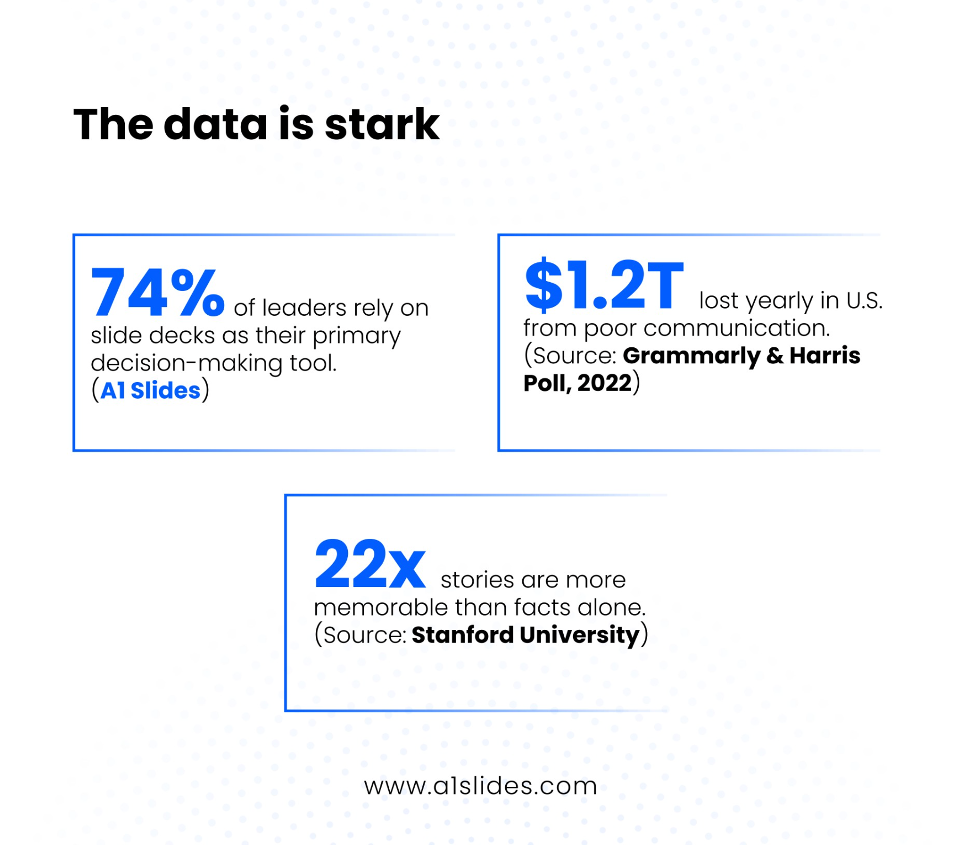Enterprise leaders face a communication crisis hidden in plain sight. U.S. businesses lose an estimated $1.2 trillion annually due to workplace miscommunication ( Source: Grammarly Study).
According to a McKinsey Global Survey, executives devote nearly 40% of their time to decision-making. However, 61% of them report that at least half of this time is used ineffectively. The culprit isn't insufficient information—it's the failure to surface actionable insights within that information.
Recent research by A1 Slides, examining executive presentation practices across Fortune 500 companies, reveals what industry analysts are calling the "Insight-to-Action Gap": executives report missing critical information in slides presented to them, not due to inattention, but because key messages are obscured by competing visual elements. When each minute of C-suite attention represents six-figure opportunity costs, this communication breakdown constitutes measurable strategic risk.
The Paradox of Data-Rich, Insight-Poor Communication
Presentations remain the primary vehicle for high-stakes business decisions. Yet 92 percent of senior leaders cite poorly structured decks as a factor in delayed or suboptimal choices. This disconnect stems from a fundamental misalignment: teams optimize for comprehensiveness when executives require decisiveness.
The consequences extend beyond individual meetings. When strategic insights fail to surface clearly, organizations experience:
- Extended decision cycles that compress competitive windows
- Misalignment cascades where unclear directives create downstream confusion
- Opportunity costs measured in delayed market entry or resource allocation
Consider the typical quarterly business review: 60 slides, 40 charts, and one strategic recommendation buried on slide 47. The presentation is complete. The decision is deferred.
The Insight-First Framework
Insight-First Design represents a structural departure from traditional presentation development. Rather than building slides to display data, the methodology reverse-engineers communication from the decision point backward.
The framework rests on three principles:
1. Primacy of Conclusion Every slide leads with the strategic implication, not the supporting data. The headline states the insight; the visualization validates it. This inversion aligns with how executives actually process information under time pressure—they seek conclusions first, then evaluate supporting evidence.
2. Visual Hierarchy as Decision Architecture Design elements serve a single function: directing attention to what matters. Color, size, position, and contrast become tools for encoding importance rather than aesthetic choices. When applied systematically, visual hierarchy reduces cognitive load by up to 40 percent according to recent benchmarking data.
3. Action-Oriented Framing Each section connects explicitly to organizational priorities. Rather than presenting findings, Insight-First Design presents implications tied to specific strategic levers: revenue growth, risk mitigation, operational efficiency, or competitive positioning.
Implementation: From Theory to Boardroom
Organizations implementing Insight-First Design report measurable improvements in decision velocity. One global financial services firm reduced average strategy approval cycles from three meetings to one by restructuring executive presentations around this methodology.
The transformation involves three operational shifts:
Content Triage Before Design Teams identify the 2-3 insights that warrant executive attention before creating any slides. This forces brutal prioritization and eliminates the tendency to present all available information.
Headline-First Development Each slide's headline becomes a standalone statement of strategic meaning. When executives read only the headlines in sequence, they should understand the complete narrative and recommended action.
Progressive Disclosure Supporting detail exists but remains subordinate. Appendices contain deeper analysis for those who need it; executive slides contain only what's necessary for the decision at hand.
The Competitive Dimension of Clarity
As AI-powered presentation tools commoditize slide creation, the differentiating factor shifts from production capability to strategic distillation. Organizations that embed clarity into their communication culture gain a measurable advantage: faster strategic pivots, better capital allocation, and tighter alignment between insight and execution.
This advantage compounds over time. Companies known for clear, decisive communication attract better strategic partners, retain executive talent more effectively, and execute more confidently because their internal intelligence flows efficiently.
Looking Forward
The enterprise communication landscape in 2025 and beyond will be defined by this reality: information abundance makes clarity scarce, and scarcity creates competitive value. The organizations that recognize presentation design as strategic infrastructure—not administrative overhead—will make materially better decisions, faster.
The question for enterprise leaders isn't whether to invest in communication excellence. It's whether they can afford not to, when every unclear slide represents strategy left on the table.
About the Research
This analysis draws from The State of Enterprise Presentations 2025, a comprehensive study of communication practices across Fortune 500 companies. The research examines presentation effectiveness, decision-making velocity, and the relationship between communication design and strategic outcomes.
For the complete research findings : https://a1slides.com/the-enterprise-presentation-outlook-2025-a1-slides-research-report/
